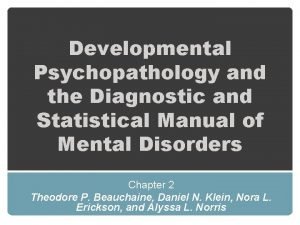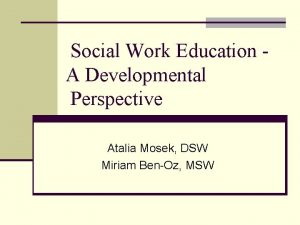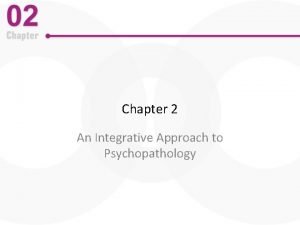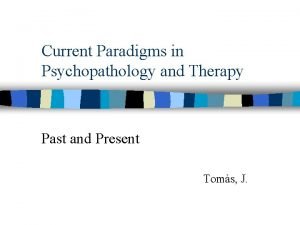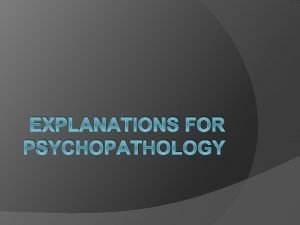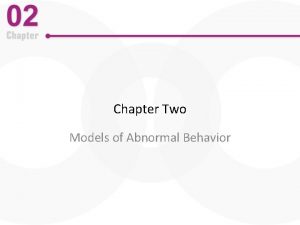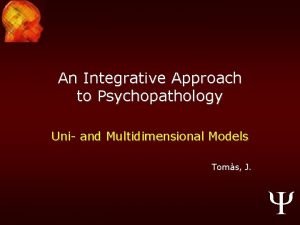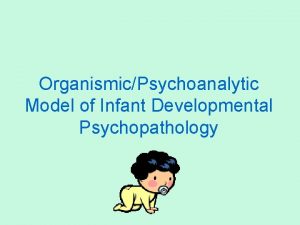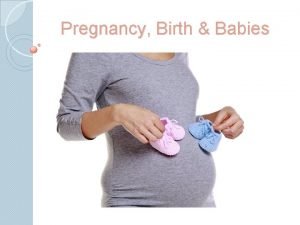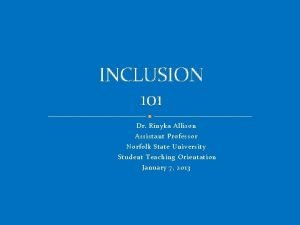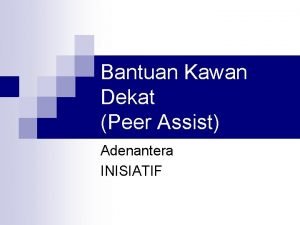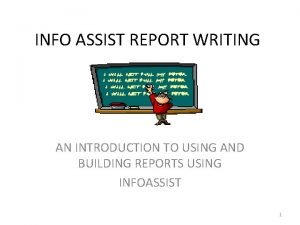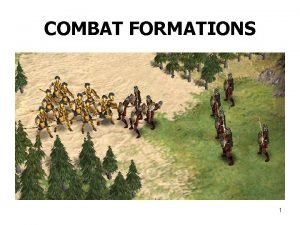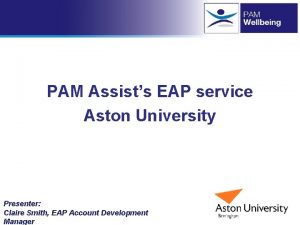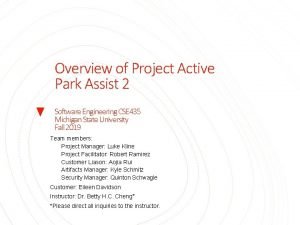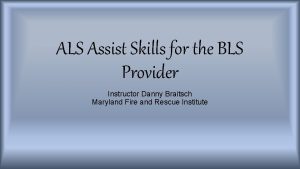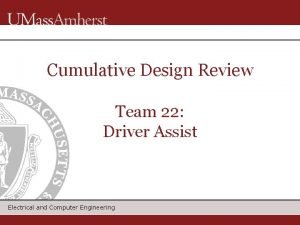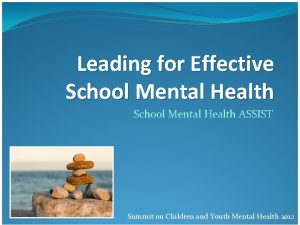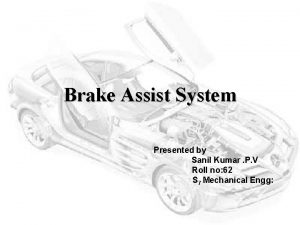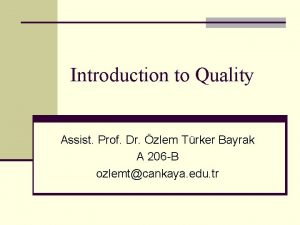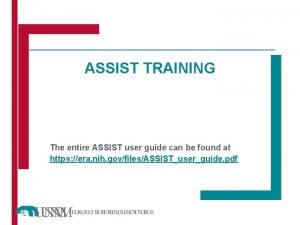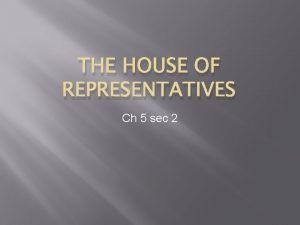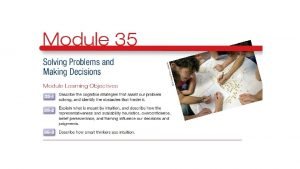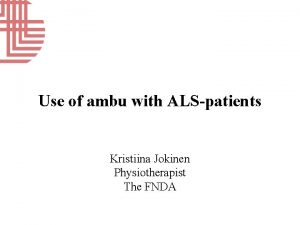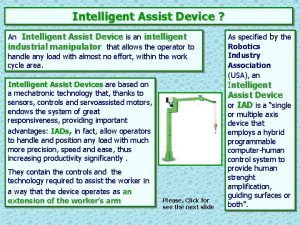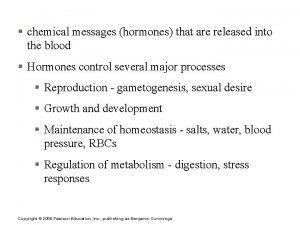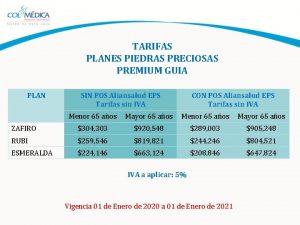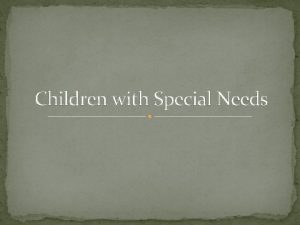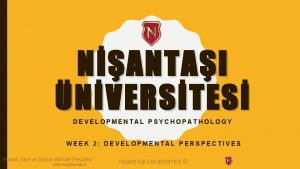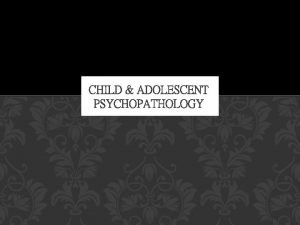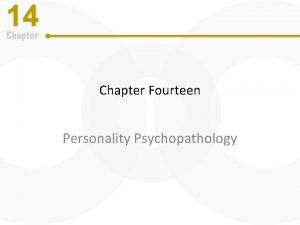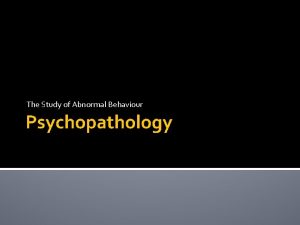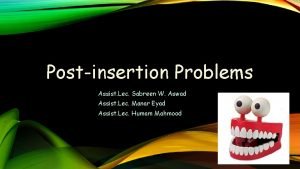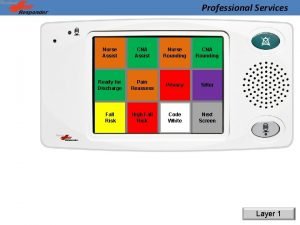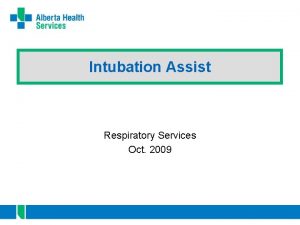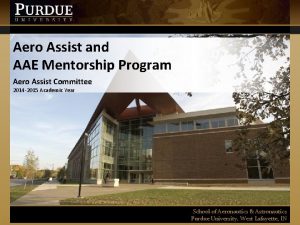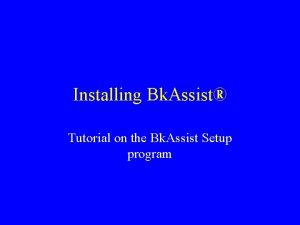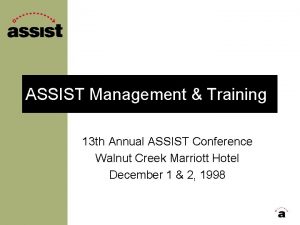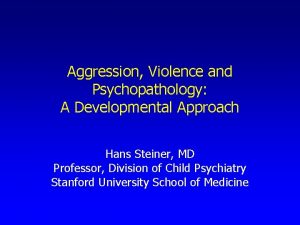Developmental Psychopathology The Developmental Psychopathology Perspective Assist Prof













































- Slides: 45

Developmental Psychopathology The Developmental Psychopathology Perspective Assist. Prof. Merve Topcu Çankaya Unıversity Spring, 2017

Models and theories • Set of principles used to analyze or explain a set of phenomena • Example: temper tantrums

Why use models/theories? 1. Intuitive scientists 2. Effective and efficient 3. Testable hypotheses

Problems with models 1. 2. May prevent us from seeing important aspects of a problem Will direct the way choose to treat the problem

How to judge a theory 1. 2. 3. 4. 5. Comprehensiveness Parsimony Empirical validity Testability Usefulness

Developmental Considerations (cont. ) • Developmental Psychopathology Perspective • Multidisiplinary field • Clinical Ψ & Developmental Ψ • stresses the importance of developmental processes • viewed as a macroparadigm • to understand maladaptive behavior, must know normative behavior • Interested in origin, developmental course, and outcome of the disordered behavior

Developmental Psychopathology Perspective (cont. ) Figure 2. 3 Developmental psychopathology as a macroparadigm. Based on Achenback, 1990).

Biological Model • Interested in underlying organic pathology; considers brain and nervous system functions as underlying causes of psychological disorders 1. Genes: produce a tendency 2. 3. 4. • Temperament: activity, emotionality, sociability, aggressive/impulsive Toxins/drugs Physical illness/trauma Neurotransmitters


Biological Models (cont. ) • Neurobiological Contributions: • different areas of the brain regulate different functions and behaviors • the endocrine system--hormones; • especially implicated in health- and stress-related disorders

Biological Models (cont. ) • Neural Plasticity and the Role of Experience • maturation of the brain is an organized, hierarchical process • consequences of traumatic experience • E. g. , Shaken baby syndrome

Benefits and drawbacks of medical model • Strengths: • Application for prevention and treatment • Reduces stigma • Takes blame off of parents • Drawbacks: • Only addresses symptoms • Fails to address environmental factors • Side effects of drugs

Psychodynamic Models • Dominated thinking for a long time • Not all that appropriate for kids • • Not motivated/self-referred Introspection limited Requires stable personality structure Doesn’t address environmental forces

Psychological Perspectives • Emotional Influences: • emotions tell us what to pay attention to and provide motivation for action • children may have difficulties in emotion reactivity or emotion regulation • temperament shapes the child’s approach to the environment and vice versa

Psychological Perspectives (cont. ) • Behavioral and Learning Influences: • • Applied Behavior Analysis --antecedents and consequences classical conditioning social learning social cognition - how children think about themselves and others

Importance of Learning Perspectives 1. 2. 3. 4. 5. 6. 7. 8. 9. Optimistic about change Simple, straightforward Downplays previous life history Leads to treatment interventions Forces us to be concrete Strong record keeping Active involvement for parents and teachers Scientific base efficient

Learning perspective problems 1. 2. 3. Tries to explain too much Doesn’t address developmental issues well Might ignore cognitions

Cognitive-Behavioral Approaches Includes thoughts/internal experiences • • • Attributions Appraisals Expectancies Examples: 1. Problem solving training 2. Impulse control training 3. Perspective taking • Limitations

Family, Social, and Cultural Influences • Ecological models • describe the child’s environment as a series of nested and interconnected structures

Family, Social, and Cultural Influences (cont. ) Figure 2. 8 An ecological model of environmental influences.

Family and Social Influences (cont. ) • Evolution and Attachment • attachment theory -- evolving child-caregiver relationship, • helps the child to regulate behavior and emotions, especially in conditions of threat or stress • 4 patterns of attachment, types of internal working models • • Secure anxious-avoidant anxious-resistant disorganized

Family and Social Influences (cont. ) • The Family and Peer Context • study of individual factors and the study of the child’s context are mutually compatible and beneficial to both theory and intervention • family system theorists study children’s behavior in relation to other family members

Concept of development • Growth Getting bigger & better Requires time Includes change over the life span Change may manifested in different ways Global structures & functions (biological, motor, physical, cognitive, emotional, social systems) become more finely differentiated and then integrated. • Development process is a coherent pattern • • • Pathways • Depends on previous & further functioning • Narrowing possibilities with age • Change is not evitably possible • E. g. , Physical change in chilhood vs old age

Multicausality • The development is influenced by a continuous interplay btw an active, changing person engaging in a complex, changing context • Understanding outcome rests on a multifactorial explanation • What causes the outcome • Direct & indirect causes • Mediation & moderation • Mediator explains the reason why there is a relationship between IV & DV • Once the effect of mediator variable is removed, the relationship disappears • Moderation • Changes the strength of an effect or relationship between two variables • A moderator may increase the strength of a relationship, decrease the strength of a relationship, or change the direction of a relationship • How causal factors work together • What underlying mechanism relies beneath • Necessary & sufficient factors • E. g. , Autism vs Schizophrenia

Example for mediation 1 • When you provoke someone, they aggress against you. But why does aggression occur? Does everyone aggress? • Some research has shown that anger is the mediator variable. • In other words, the provocation causes anger, and its the anger that causes aggression. Thus, provocation (IV) causes anger (M) which causes aggression (DV). • IV: Provocations • DV: Aggression • Mediator variable: Anger 25

Example for mediation 2 • IV: Social class • DV: Frequency of check up • Mediator variable: Age, money Money Social Class # of checkups 26

Example for moderation IV: Disagreement w/ friend DV: Drinks at home Moderator variable: Avoidant coping style 27

Qs? 1. Receiving a harassing email from a coworker leads to feelings of anger which reduce overall job satisfaction. Does this describe mediation of moderation? 2. Access to free treats during break creates positive emotional responses for workers except for those who have high negative affect (i. e. , who are perpetually grumpy). Does this describe mediation or moderation? 28

Pathways of development • Abnormal behaviour does not appear out of blue • 5 different developmental pathways from early to late adolescence, with respect to children's adaptive or maladaptive behavior. 1. Stable adaptation 2. Stable maladaptation 3. Reversal of adaptation 4. Decline of adaptation 5. Temporal maladaptation

Equifinality & Multifinality • Equifinality • A given outcome can be reached from any number of different developmental paths. • Multifinality • Similar initial conditions may lead to dissimilar outcomes

Risk & Resilience • Risk factors • Increases the chance of psychological impairments Moderators • Child characteristics • Environmental characeristics Stressors • Major life events • Minor events • Chronic conditions Mediators Biological, Psychological, & Social processes Psychopathology • Symptoms • Syndromes • Disorders

Risk & Resilience • Constitutional risk factors • • • Heredity Gene abnormalities Prenatal, birth complications Postnatal Inadequate health care, nutrition • Family • Emotional & interpersonal • Low self-esteem • Difficult temperament • Peer rejection • Intellectual & academic • Below average intelligence • Learning disability • Ecological • Crime , injustice, discrimination • Nonnormative stressful life events • Early death of a parent • Outbreak of war

Risk & Resilience • Multiple factors • Timing of the potential risk • Predictability of the risk factors • Multifinality • Risk factors for onset may be different from persistence of the disorder • Risks accumulate over time, & make more vulnerable for future

Risk & Resilience • Positive outcome in the face of adversity • Those who maintain healthy functioning • • Absence of psychopathology or low level of symptomatology Competence regarding developmental tasks Adaptability Trio of protective factors 1. Personal attributes of the youth 2. Family characteristics 3. Support from outside family • Rutter’s description of four protective mechanisms 1) 2) 3) 4) Reduction of risk impact Reduction of negative chain reactions Establishment and maintenance of self-esteem and self-efficacy Opening up of opportunities

Continuity & change • Does a behavior disorder at an earlier time in life carry over, or predict, the disorder later life? • Discomfort & growth • Stable symptom presentation over time? • Heterotypic continuity • Processes are responsible for change • R/ship btw temper tantrums & ill-tempered motherhood 1. Cumulative continuity 2. Interactional continuity

Early attachment • Emotional –social bond btw child & caregiver is called attachment • Seen in 7 -9 months • Organized pattern of behaviors that protect child against high levels of fear in stressful situations • Ainsworth, the Strange situation • In predetermined schedules, mothers leave the babies in the room • Babies are observed • Types of attachment styles • Secure • Not distressed at separation • Easily soothed • Positive reaction to mother’s return • Insecure attachment • Avoidant type • Avoid contact when mother returns • Not easily soothed

Early attachment • Disorganized / disoriented attachment • Lack of consistent strategy to organize behavior under stress • Children’s of parents who are depressed or use alcohol or drugs • Seeing parent threatening • • • Academic problems Later emotional & behavior problems Low self-esteem Poor peer interaction Bizarre classroom behavior • Need research on biological bases • Attachment patterns are not stable over time • Internal working models may change

Temperament • Basic disposition • Thomas and Chess’s Temperament Types • Heredity, neural, and hormonal factors affect response to the environment. • can be modulated by environmental factors; parental response. • “Goodness of fit”: • the degree to which an individual’s temperament is compatible with the demands and expectations of his or her social environment • Parents can modulate children’s temperament by their influences on the environment.

Temperament • Thomas and Chess’s Temperament Types • Easy babies: 40% of infants • adjust easily to new situations, quickly establish routines, are generally cheerful and easy to calm. • Difficult babies: 10% of infants • slow to adjust to new experiences, likely to react negatively and intensely to stimuli and events. • Slow-to-warm-up babies: 15% of infants • somewhat difficult at first but become easier over time.

Temperament 9 dimensions 1. Activity Level: • How active the child is generally • Highly active children may channel such extra energy into success in sports 2. Distractibility: • The degree of concentration and paying attention displayed when a child is not particularly interested in an activity 3. Intensity: • The energy level of a response whether positive or negative • Does the infant react strongly and loudly to everything, even relatively minor events? • Good at drama 4. Regularity: • The trait refers to the predictability of biological functions like appetite and sleep. • As grown-ups irregular individuals may do better than others with traveling as well as be likely to adapt to careers with unusual working hours.

9 dimensions (cont’d) 5. 6. 7. 8. 9. Temperament Sensory Threshold: • Related to how sensitive this child is to physical stimuli • Highly sensitive individuals are more likely to be artistic and creative. Approach/Withdrawal: • Refers to the child’s characteristic response to a new situation or strangers. • Slow-to-warm up children tend to think before they act. • They are less likely to act impulsively during adolescence. Adaptability: • Related to how easily the child adapts to transitions and changes, like switching to a new activity. • A slow-to-adapt child is less likely to rush into dangerous situations, and may be less influenced by peer pressure. Persistence: • This is the length of time a child continues in activities in the face of obstacles. • The highly persistent child is more likely to succeed in reaching goals. • A child with low persistence may develop strong social skills because he realizes other people can help. Mood: • This is the tendency to react to the world primarily in a positive or negative way. • Does the child see the glass as half full? • Serious children tend to be analytical and evaluate situations carefully.

Temperament • Behaviorally inhibited temperament • When exposed to unfamiliar stimuli in infancy, they are biologically reactive • They are known as shy & socially w/drawn • Associated w/ later anxiety & depression

Emotional regulation 1. Feelings 2. Overt expressions 3. Autonomic nervous system arousal • By the age of 2 -5, connections between emotions & cognitions are established • Also shaped by social context • Development of sympathy and conscious for others

Social - Cognitive Processing • Thinking about the social word • Crick & Dodge’s (1994) Social – Cognitive Processing Model

Social - Cognitive Processing • Interpretation of the cues can play in maladaptive behavior • Attention starts the processing • Emotion is viewed as playing central role in theory
 Developmental psychopathology approach
Developmental psychopathology approach Developmental perspective social work
Developmental perspective social work What is psychopathology
What is psychopathology Integrative approach to psychopathology
Integrative approach to psychopathology Current paradigms in psychopathology
Current paradigms in psychopathology The supernatural tradition
The supernatural tradition Multipath model of psychopathology
Multipath model of psychopathology Garrett model of speech production
Garrett model of speech production Multidimensional integrative model
Multidimensional integrative model Psychopathology
Psychopathology Hallway perspective drawing
Hallway perspective drawing Silo perspective vs business process perspective
Silo perspective vs business process perspective Redcap choa
Redcap choa Gx assist side effects
Gx assist side effects One teach, one assist pros and cons
One teach, one assist pros and cons Peer assist adalah
Peer assist adalah Info assist
Info assist Fire team formations
Fire team formations Pbx call assist 2
Pbx call assist 2 What does pam assist stand for
What does pam assist stand for Counseling sheet usmc
Counseling sheet usmc Active park assist 2
Active park assist 2 A defective vacuum brake booster will cause a ________.
A defective vacuum brake booster will cause a ________. Als assist
Als assist Assist electrical
Assist electrical School mental health assist
School mental health assist Cisco smart assist
Cisco smart assist Conclusion of brake system
Conclusion of brake system Second heart assist
Second heart assist Missionassist
Missionassist Quality assist
Quality assist Assist user guide
Assist user guide The whips assist the party leaders by
The whips assist the party leaders by What cognitive strategies assist our problem solving
What cognitive strategies assist our problem solving Bmv ambu
Bmv ambu Intelligent assist device
Intelligent assist device Cisco smart assist
Cisco smart assist Thymosin and thymopoietin assist in the maturation of:
Thymosin and thymopoietin assist in the maturation of: Mediassistindia login
Mediassistindia login Plan zafiro guía premium colmédica
Plan zafiro guía premium colmédica Aig travel assist
Aig travel assist Các loại đột biến cấu trúc nhiễm sắc thể
Các loại đột biến cấu trúc nhiễm sắc thể Lời thề hippocrates
Lời thề hippocrates Vẽ hình chiếu đứng bằng cạnh của vật thể
Vẽ hình chiếu đứng bằng cạnh của vật thể Phản ứng thế ankan
Phản ứng thế ankan Kể tên các môn thể thao
Kể tên các môn thể thao
